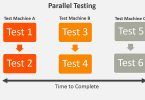The Enterprise Architecture Center Of Excellence, or commonly known as the EACOE, is the industry name in advancing enterprise architecture as a concept and a business sector. It operates under the assumption that strategic enterprise architecture is necessary for businesses to be successful in a post-digital transformation era.
As such, EACOE is the leading resource for industry professionals to learn about enterprise architecture, while learning how to implement methodologies and disciplines using standard best practices.
The EACOE Framework, also known as Enterprise Architecture Framework, and commonly known as the Zachman Framework, is the recognized resource for best practices in enterprise architecture.
Below, we will discuss:
- Enterprise architecture, as a general concept;
- Enterprise architecture, specific to the EACOE framework; and
- How to best apply what you’ve learned to your enterprise infrastructure.
If you’ve been thinking about organizing your enterprise architecture, keep reading.
Enterprise Architecture
The EACOE, the leading experts on enterprise architecture, defines this concept as:
[A] kind of planning based on the strategic vision of the company. It helps in creating a synergy of the firm’s various capabilities and guiding them towards strategic goals. It lays out a clear framework of a company’s structure, personnel, technology and business, called enterprise architecture framework.
Enterprise architecture is a system that relies on graphic impact to convey important context and business insights, driven by domains, layers, and various views. The EACOE provides the foundation for enterprise architecture with its framework.
More than twenty years ago, businesses began realizing the key to operations success was people, process, and technology.
That may have become the enterprise buzzword of the century but embodying it took strategy. Stakeholders learned that mapping people, processes, and technology simply was not enough, they needed to be able to add other more abstract layers and concepts like goals, objectives, and values.
The reason enterprise architecture is so important is that it helps companies get more of a transparent view of how their people, processes, and technology interact with various other aspects of the business.
Types of Enterprise Frameworks
There are several types of enterprise frameworks. Although we’re focusing on EACOE today, also known as the Zachman Framework, there are three other frameworks used widely across different industries. All deserve an honorable mention in this blog:
Zachman Framework
The Zachman Framework is the one on which we’ll focus. More to come on this below, but the Zachman Framework is an innovative framework focusing on the intersection between stakeholder interests and business-critical questions.
The Open Group Architectural Framework
The Open Group Architectural Framework, or TOGAF, is a very common enterprise architecture framework used by many businesses today. It combines best practices and suggested resources and methodologies.
Federal Enterprise Architectural Framework
The Federal Enterprise Architectural Framework, or FEA, is a system of architecture designed for government bodies. It was developed in 2006 and combines principles from the aforementioned Zachman and TOGAF disciplines.
Gartner Framework
Gartner’s model sticks out from the others and offers a perspective that’s completely different. It beckons companies to constantly adapt the technology around them. Gartner’s principle is based on the operating team acting as one unit. Therefore, instead of a single domain, correction and re-correction is the key to unification and alignment of goals and values.
What is EACOE Framework?
The EACOE endorses the Zachman Framework.
The Zachman Framework was created in 1987, by John Zachman, who worked for IBM. It was innovative and has been elevated to become the global standard in enterprise architecture.
At its core, the EACOE framework takes the questions, “Who? What? Where? When? Why?” and “How?,” looking at how these questions, and the resulting answers, intersect with six stakeholder groups: Visionary, Owner, Designer, Builder, Implementer, and Worker. In theory, depicting these connections gives enterprise architects the basis for the entire enterprise model, when combined with context from five important factors:
- Business Descriptions
- Business Relationships
- Technology Neutral
- Technology Specific
- Solution Specific
This sounds like a complicated web of connections, and in some ways it is. But by systematically applying the Zachman Framework, enterprise architects can use tried and true best practices to map synchronicities between people, processes, and most importantly, technology.
A Closer Look
The framework challenges the previous concepts of its predecessors in terms of the system development life cycle.
Antiquated models of system development life cycle look something like this:
Strategize: This is the planning phase;
Analyze: During this phase, requirements are determined;
Design: The act of using technology and innovation to complete requirements;
Construct: Building the system and framework;
Document: The design and implementation of user materials and guides;
Transition: Roll out of the new system; and
Production: Monitoring and maintaining.
The Zachman approach abandons this old methodology in favor of a process that charts the perspective of each important stakeholder in the process, across a number of questions and interests in a grid.
Zachman Columns & Rows
The Zachman Framework looks at enterprises as a grid of stakeholder interests, their interactions and the resources supporting them, along with a string of questions that flush out the requirements of each interest.
Rows:
Below are the rows used in a EACOE grid:
A Visionary’s Perspective: This view offers insight into business strategy and purpose, offering necessary context to the whole.
An Owner’s Perspective: This view offers a business description in terms of what the business is supposed to achieve, offering context to what resources are needed.
A Designer’s Perspective: Through this viewpoint, the designer develops a system that meets the business objectives of the enterprise.
A Builder’s Perspective: The builder defines how a system will be built and is concerned with information architecture, offering context to an enterprise’s technology.
An Implementer’s Perspective: The implementer has coordinated all moving parts for a successful rollout. Mapping this perspective lets stakeholders see what needs to be done for implementation while connecting each part with corresponding business objectives.
A Worker’s Perspective: This is an operational view of the system functioning in its native environment.
Columns:
Below are the columns used in a EACOE grid:
- Data (What?): What data is essential to the functioning of the enterprise?
- Function (How?): How does the business operate?
- Network (Where?): Where do the businesses operate?
- People (Who?): Who are the people involved in ensuring the business operates at every level?
- Time (When?): When are business operations performed?
- Motivation (Why?): Why choose this solution? What factors determined the choice? What motivators fuel operations?
Using these seemingly simple cross-sections, the Zachman Framework invites stakeholders to align their interests with common business goals.
Zachman Framework for Your Business
Why use the Zachman Framework?
The short answer is it makes it easier for enterprise businesses to respond to changes. The lag in response time for larger organizations can sometimes be chalked up to mistaken notions of a lack of understanding about the interconnectivity of internal systems.
Among its many important functions, the Zachman Framework offers a classification system for the non-tangible items and experiences that make up an enterprise.
Another important function is change management within businesses. When high-level changes are made in things like strategic vision, an updated Zachman Framework offers a greater context while deepening stakeholders’ understanding of enterprise goals.
These postings are my own and do not necessarily represent BMC's position, strategies, or opinion.
See an error or have a suggestion? Please let us know by emailing blogs@bmc.com.






